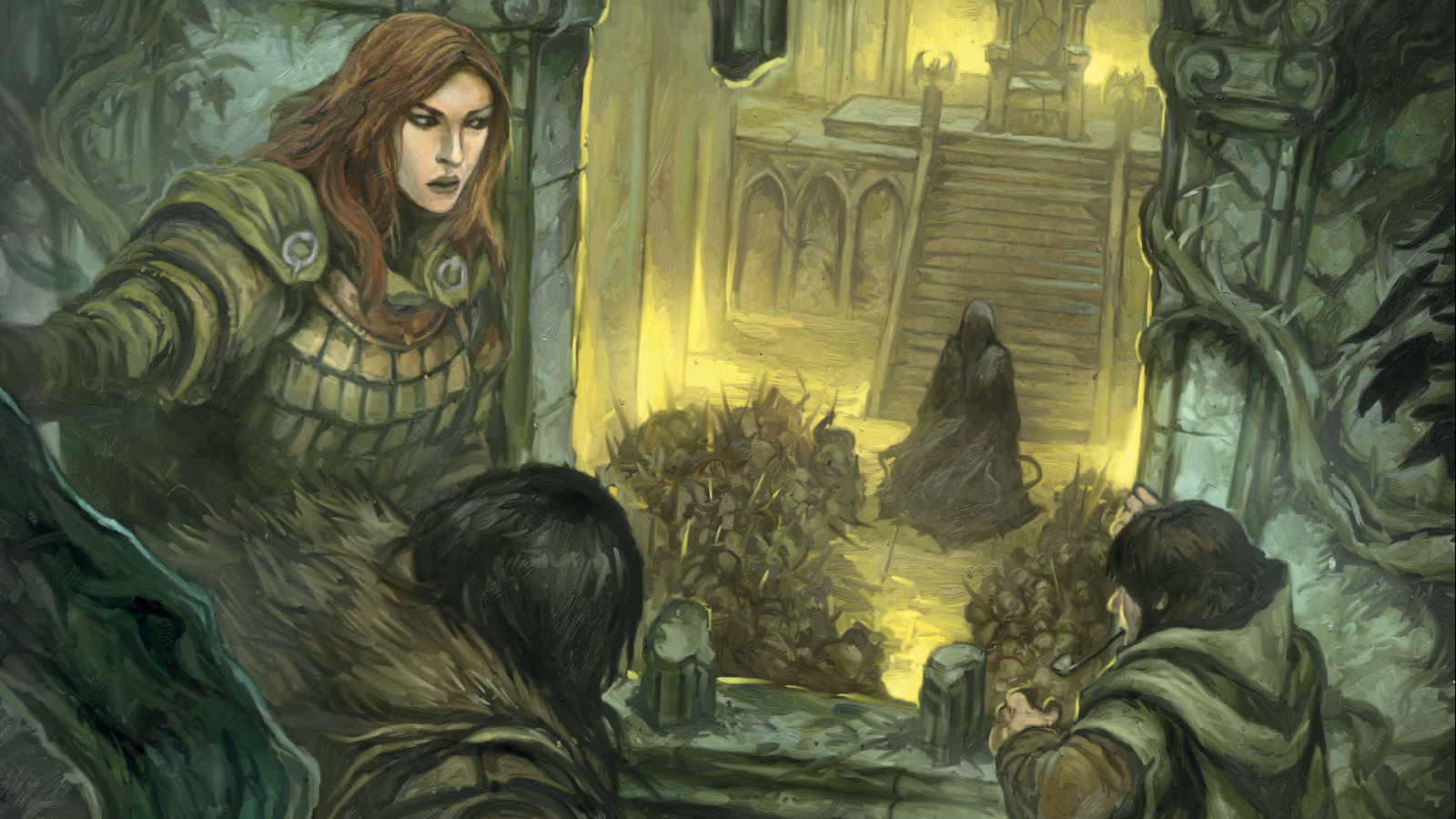Disclaimer: the art in this post is copyright Cubicle 7. I do not own the pictures. I am putting up here to showcase the style they use in their games for this review.
One of my friends stepped up to GM for our RPG group and has been running the Iron Kingdoms RPG for a few months, with some Warmachine thrown in for larger battles (though Warmachine is more of a mass combat game rather than a wargame – more on that in a future post).
He’s been a bit busy, so I decided to dip my hand back into GMing again, and for the first time in many, many years, use a pre-generated setting. The setting I chose was Middle Earth, having been drawn in by Cubicle 7’s excellent game, The One Ring (TOR).
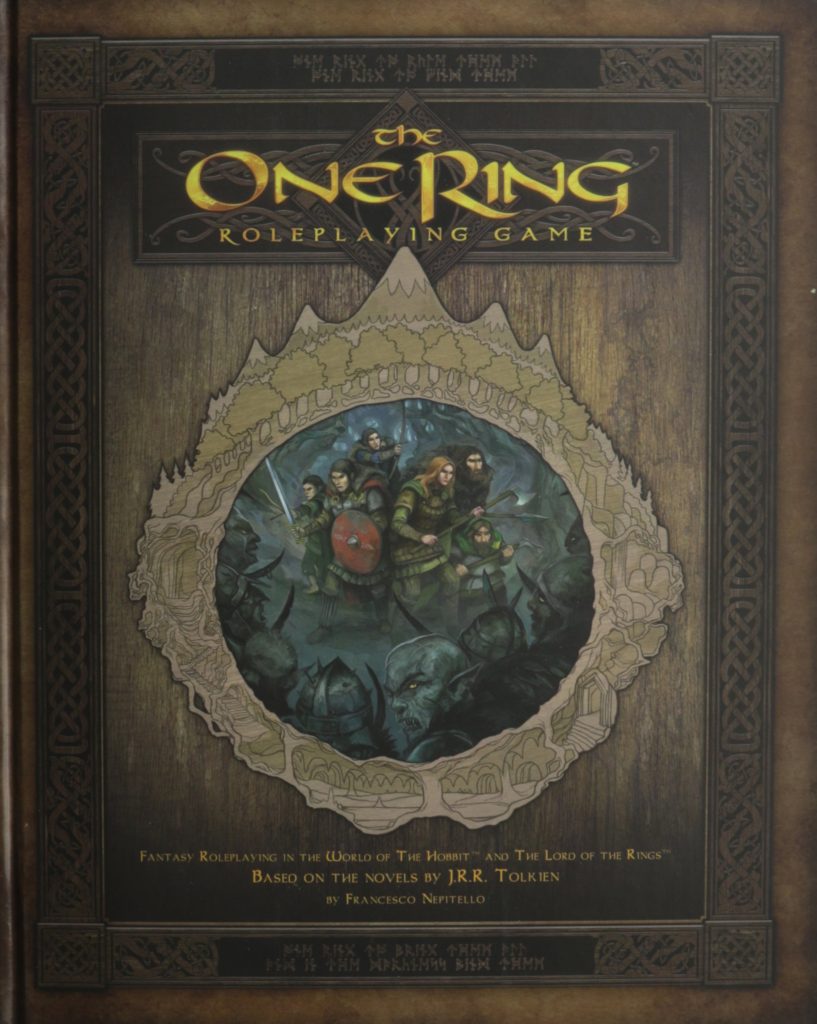
TOR uses one d12+d6s based on skill level for resolution, with a novel fatigue and injury system. It is properly heroic without being overpowered and really captures the feel of Middle Earth. For instance, you can remove your helm (and increase the risk of being wounded) to reduce your fatigue and be able to better strike your enemies as you grow more tired in battle. Combat is abstract, designed to be used without miniatures and is based on stances. The stances are about risk/reward, which is a nice change from the standard “you hit the orc, the orc hits you.” I have yet to play it, but it really strikes me as a great game for Middle Earth.
Despite my keen interest in TOR, I know that my group really likes gridded combat with as many tactical options as possible. I therefore took a look into Cubicle 7’s other Middle Earth offering: Adventures in Middle Earth (AiME) and am very glad that I did. AiME is a modification of the core 5e rules and is excellent. It is by far the best d20 based rule set I have seen. It is low magic but retains a strong sense of fantasy. It even improves on the already innovative journey and audience rules that are in TOR. Items get more powerful as characters do, and wealth is less important than in many other games, with social interactions and trust built over time being more important than silver or gold.
Compared to 5e, the cultures, classes, and even magical items have a much better feel and have very different roles across play. Where balance in 5e is all about everyone having an equal part to play in battle, AiME allows characters to shine throughout the game. That said, the combat rules are detailed and fun, and have all kinds of tactical options allowing for ruins, swamps, and forests to be used to best advantage. There is a corruption mechanic (shadow) that reflects the influence of Sauron and the despair a character can experience. In fact, almost all of the core 5e rules have been modified to be as close to Tolkien as possible for D&D. Characters choose a culture, a class, and background. Each has a real mechanical impact on the game. The cultures reflect the peoples around the Mirkwood, and each has its own virtues (which are like feats but far more interesting), cultural heirlooms and skill sets. The backgrounds feed into roleplaying with an inspiration mechanic that is modelled on the concept of hope in Tolkien’s written work. The resulting heroes are balanced and have mechanical reasons to invest in non-combat skills and be part of the greater fabric of Middle Earth. The game really tries to reduce the murder-hobo concept that dominates D&D and as we shall see, it does a good job.
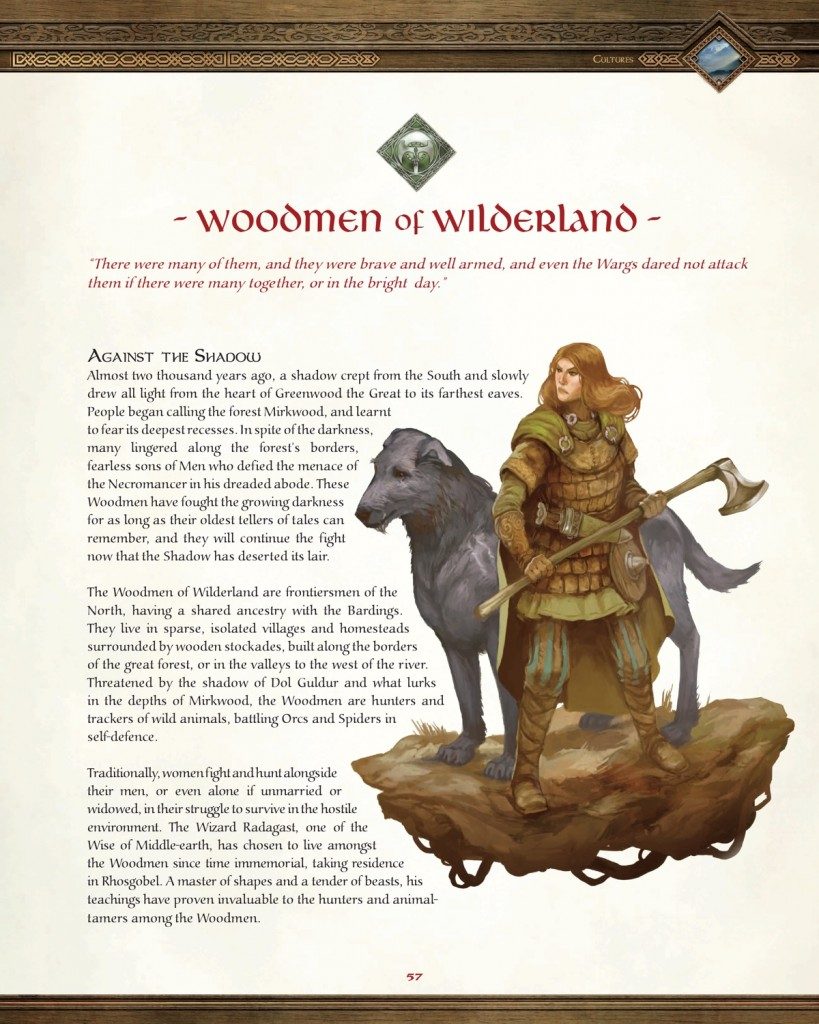
So, having a ruleset and the Wilderland Adventures I suggested running AiME about once a month when our Iron Kingdom GM was unavailable. Using an established setting and campaign would make it less onerous to run, and it was a familiar world to all. Additionally, AiME is designed to have breaks in adventuring, with a set Fellowship phase, where people live in the world for a bit. It is recommended that only 2 or so adventures happen a game year. This means that a once a month game will actually help accentuate that impression of time passing. It is also great as you can have a campaign span 30 years!
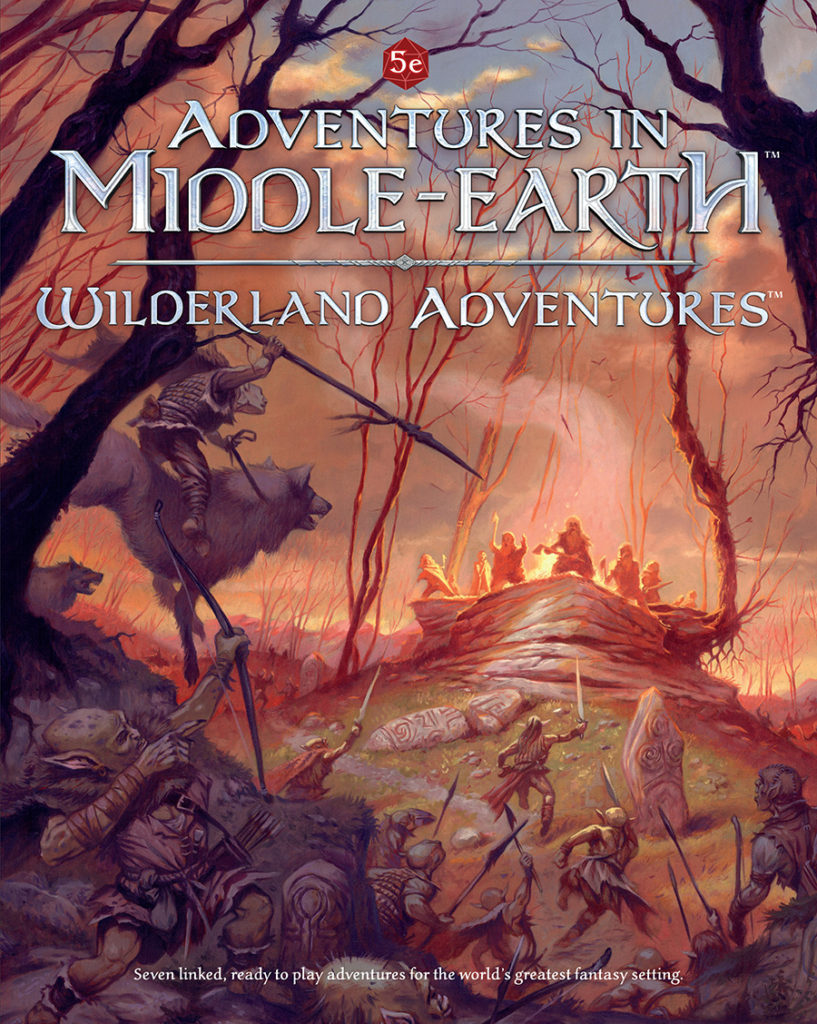
Now onto a quick report on how the first adventure played out.
*** Spoiler Alert ***
If you are going to be a player in the Wilderland Adventures (for TOR or AiME) stop reading here.
********************
The party consisted of a Dwarf warrior, a Dwarf rogue, a Wood Elf scholar, and a Dunedain warden (similar to a bard but more combat oriented and not at all responsible for opening cell doors).
I rather clumsily started the adventure with the party wandering the edge of the Long Lake near the ruins of the original Lake Town discussing what to do when the passes over the mountains open. Out of nowhere a shout rings out. The pretty Dunedain warden was too busy thinking of how impressive he was to notice. He failed 7 perception rolls over the course of the night, always by a large margin, most of them with a critical failure. I ended up changing his heirloom to a mirror as he clearly was admiring himself and not his surroundings!
The others were more aware and all ran to help the boy who was screaming that his father was being attacked by his own guards. Covering the ground quickly, they saw the merchant in the trees with his back to a tree holding a branch in his hand while 3 thugs threatened him.

The treasure hunter ducked into the bushes as the warden shot to lightly wound. He messed up and did real injury. The thugs then tried to bribe the party to look the other way as they took care of the merchant, but the boy cried out and was restrained by the elf. The warrior charged, figuring that being asked to turn the other way while a murder happened was not on. He swung hard but missed, as did the treasure hunter (despite advantage) who got a thump on his head for his trouble. The warrior’s armour took a blow and the warrior then hit the leader. Not expecting this much violence, the thugs gave up and were detained by the party. After properly introducing themselves to the merchant Baldor and his son Belgo, they all agreed to return to the new Lake Town, restock (and heal up) and turn the the three reprobates over to the bailiff before escorting Baldor through the Mirkwood. The three thugs were known to have supported the old Master of Lake Town, and now that he disappeared, they’ve taken to odd jobs so the bailiff was unsurprised to see them.
I’ll note here that the party had really think to adapt from a traditional D&D murder-hobo style for that first encounter. Seeing the thugs threatening a man they had to consciously hold back from immediately killing but the cost from shadow (corruption) mechanic and the benefits character builds reinforced good behaviour.
After returning to the path, the party, now escorting the thankful Baldor, his son, and his ponies across Mirkwood, met up with some Woodland Elves who had earlier arranged to meet Baldor and buy some goods. Rafting into the Woodland Realm they got to try audience rules and wisely had the elf and Dunedain speak up as Dwarves were no help, especially the socially impaired treasure-hunter.
After a nice meal and a good rest they got on the main trail and went into the fastness of the Mirkwood, being careful to remain on the path. I explained the journey rules and the roles the party had to play and the possible outcomes. The journey rules have each member of the party assume a role. The guide has to roll for how the journey starts, and then random journey events will test the skillsets of the all of the members (scout, hunter, lookout). All of these rolls influence outlook, giving shadow points or exhaustion or bonuses depending on how the journey went. This really reinforces the idea that journeying to a ruin is not a simple undertaking but must be planned carefully. That same journey though, becomes an adventure in and of itself, which I really like.
The departure roll in this case didn’t go with the party getting depressed wandering in the dark, dank wood, gaining a shadow point each. That evening, the first event had the party surprised by King Thranduil and his guards. The King was actually most impressed by the grumpy treasure hunter, who had a short discourse with the royal party about the King’s hunt for the White Hart. The King then advised the party to prepare to sacrifice a pony if one of the greater spiders attacked and rode off into the darkness.
Rather overwhelmed by the encounter, Baldor and Belgo went to get a drink from a nearby stream. Belgo started to scream and Baldor ran off into darkness The party stood to immediately. Belgor was beside himself, saying that his dad drank the water and didn’t recognize him and was shouting about the dragon fire and his wife (who died during the burning of Lake Town 5 years ago). Leaving the 2 dwarves to console the child and guard the camp, the Elf and Dunedain tracked Baldor up the stream to an old ruin.
Note, the published adventure has Baldor go mad in front of the party but leaves the party unable to restrain him. In order to maintain agency, I had the madness happen “off screen”. I made other minor adjustments to the adventure to set the ground work for future aspects of the campaign and to clean up some poorly disguised railroading.
There, suspended in a web was Baldor, but also a giant eagle. The elf climbed up the webbing and freed Baldor, but the webbing began to quiver. The group rushed to free the eagle and convinced it to take the confused merchant back to the party. The two heroes booked it back towards the camp.
Back at the camp, the eagle flew off immediately and soon after a large spider approached. The fire was built up and as the spider came out, it was warded off by some flaming brands. As the party reunited more spiders appeared, with 3 pressing the attack. These spiders were tough, and potentially deadly, but the party did well and killed all 3 while taking only a few wounds. The group then set alight some of the webbing in the woods and ran down the path, hoping to put as much distance between themselves and the spiders as possible.
As they ran rain began to fall and it became miserable out in the dark. Though Baldor began to regain some of his memory his son was still upset, but had taken a shine to the gruff treasure hunter. The cold rain and wind were going making the going hard and the Dwarves wanted to get the humans into someplace dry quickly. Luckily the party spotted a bit of smoke rising from what seemed to be a hollow tree. Being very mindful of social niceties, the group didn’t wait in the tree for its owner after searching inside, but rather outside to ask permission. In short order a stinky hermit showed up and, after being given some food, calmed down invited the party to stay in shelter as the storm passed. The party did extraordinarily well due to their social acumen and that really reinforced playing a respectful adventurer.
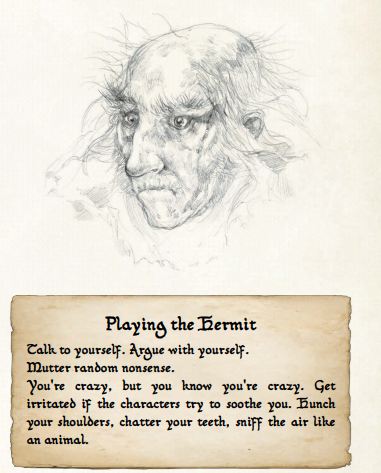
Feeling refreshed the party began to head out, the day was nice and getting warmer, and there was even a bit of sunlight filtering through the trees. Up ahead a large clearing looked like a good place to rest, and in the middle was an old stone well. The warrior was very interested in it as the others flopped down to enjoy the Spring sun. But the Mirkwood is full of deceit and tentacles came out of the well and attacked the warrior as he investigated, trying to pull him in. The party responded quickly and did a great amount of damage to the thing in the well in just 2 short rounds and it withdrew, leaving some mangled tentacles behind.
The clearing began to look menacing so the party moved on quickly. In a few more days the party was almost at the Forest Gate. Just before they got out the final journey event had them run into some goblins. The party surprised the goblins and quickly took them out. 2 ran for it and the treasure hunter chased them, stepping off the path. The Dunedain followed and soon both were lost under the eaves of the Mirkwood. They had wounded 1 of the goblins with a called shot (and killed the other) so captured it. They bargained with the goblin to have it lead them back to the path in exchange for freedom. The goblin agreed and soon the party was reunited.
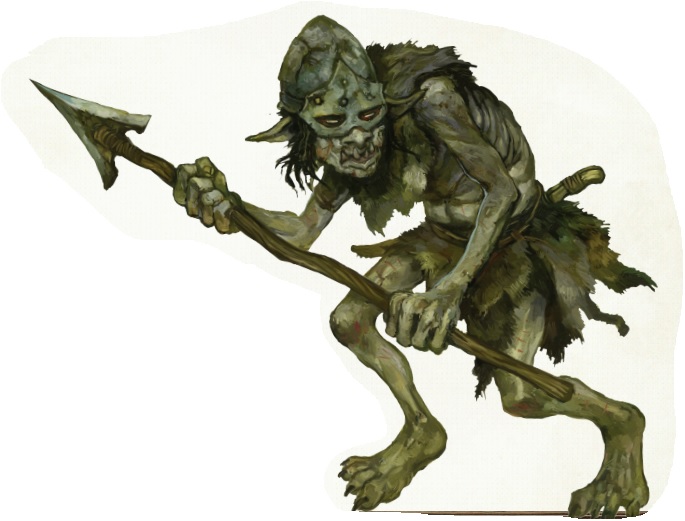
The treasure hunter bent over as the goblin turned to the Dunedain to receive its freedom. The burglar cut the goblin’s ankles from behind, crippling it. The goblin shouted that they had promised to let it go as it fell on the ground. The treasure hunter (who detests goblins even more than most Dwarves) said the goblin was free to go and should be thankful. As the noise grew the warrior stepped in and put the goblin out of its misery before spiders came to eat them all. The treasure hunter earned more shadow points for that, and the rest of the party was actually uncomfortable with his actions, which speaks to the ruleset. In 3 hours the group had bought into the Middle Earth mindset, which is great and speaks to the well designed system.
The Forest Gate and the end of journey was next, with the party ending the journey on a high note, gaining advantage on social interaction checks. They then headed down to the Most Easterly Inn, from where they will start their next adventure. It was a good session, despite some rough descriptions on my part, and I think everyone enjoyed the setting that they knew. The adventure itself was easy to run with minimal prep. While there were some problems, the Wilderland Adventures are overall very well done and I shall continue to use them.
AiME is a great version of 5e, and I am definitely planning on using it as the basis for the ruleset for my homebrew world in a year or so. If you play 5e, or Pathfinder or any OSR clone, I highly recommend you check out AiME as it has great ideas for even high fantasy realms. The books are high quality but are expensive. If you buy from Cubicle 7 you get the pdfs and the hard copy. If you are concerned about cost, the pdfs are more reasonable, and both the Adventurer’s and the Loremaster’s Guide are worth it.
